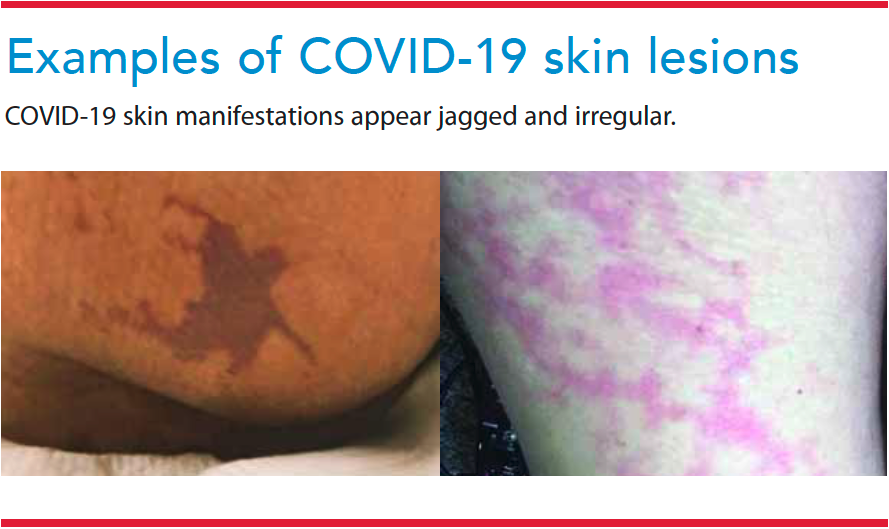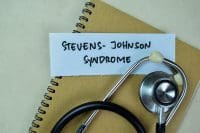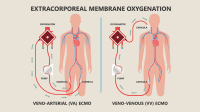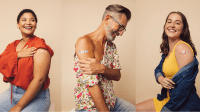Correct identification ensures appropriate treatment.
- The inflammatory-induced coagulopathy associated with COVID-19 places patients at risk for a unique skin manifestation.
- COVID-19 cutaneous skin manifestations can mimic deep-tissue injuries in color and size, but they don’t occur over traditional pressure or shearing areas.
- Distinguishing between COVID-19 skin manifestations and DTI aids identification, reimbursement, and treatment.
Although most care management for patients with COVID-19 focuses on the respiratory system, the virus impacts almost every system, including the skin. The inflammatory-induced coagulopathy associated with COVID-19 places patients at risk for a unique skin manifestation. Unfortunately, this condition has many characteristics similar to deep-tissue injuries (DTIs). Learning how to identify COVID-19 skin manifestations can help ensure quick diagnosis and intervention.
What’s deep-tissue injury?
DTIs, preventable healthcare-acquired pressure injuries (HAPIs), typically occur in patients with mobility and sensory impairment. They’re characterized by maroon- or purple-colored skin over a boney prominence or related to a medical device. Frequent turning, placing the patient on their side at 30 degrees using foam wedges, and applying skin barriers, such as foam dressings, can help prevent DTI. The Centers for Medicare & Medicaid Services won’t reimburse hospitals for the care of this condition and may apply a value-based penalty fee. In addition, all HAPIs are publicly reported and used to describe an organization’s quality of care.
Keys to understanding long COVID
Nursing care plan for outpatients with mild-to-moderate COVID-19 disease
What are COVID-19 skin manifestations?
COVID-19 cutaneous skin manifestations can mimic DTIs in color and size, but they don’t occur over traditional pressure or shearing areas, according to Black and colleagues. Although the lesions have a purpuric appearance, they’re not considered a pressure injury or DTI because they lack the element of positioning over a defined pressure point. Other skin manifestations related to COVID-19 include chilblain-like (frostbite-like), urticarial (hives), and varicella-like lesions. (See Other skin manifestations.)
Other skin manifestations
Patients with COVID-19 also may experience the following skin manifestations:
Chilblain-like (frostbite-like) lesions
- Sudden red or purple coloring of the toes and fingers
- Painful burning sensations, itching
Urticaria (hives)
- Red skin lesions (wheals)
- Itching or burning
- May disappear in one area within 24 hours and then appear again elsewhere
Varicella-like lesions
- Viral exanthem rash (spots, bumps, blotches) on the chest, stomach, and back
- Scattered distribution
- Mild or no pruritus
COVID-19 pathology includes inflammation and a hypercoagulable state, which involves both venous and arterial thrombi. The skin is one of the many organs adversely impacted by this coagulopathy, but the exact mechanism of action is unclear.
Distinguishing between COVID-19 skin manifestations and DTI aids identification, reimbursement, and treatment. Treatment for COVID-19 skin manifestations includes prolonged healing times and addressing infection concerns that don’t occur with DTIs. Treatment for DTI consists of offloading pressure to the site; however, this same treatment won’t improve COVID-19 skin manifestations.
Recognition
Recognizing a COVID-19 skin manifestation begins with confirming a positive diagnosis of COVID-19. Within the intensive care setting, patients with severe cases of COVID-19 frequently experience lesions that mirror a DTI. These lesions include retiform purpura (angulated or branched pattern), purpura/purpura lesions (pooled blood under the skin), and livedoid and necrotic lesions (red or purple spots and tan, brown, or black leathery skin). However, because they’re not related to prolonged pressure, these skin manifestations have defined characteristics likely related to coagulopathic states.
An elevated d-dimer (breakdown product of clotting identified with a blood sample), a consistent finding in patients with COVID-19 skin manifestations, reflects coagulopathy. The shape of the skin lesion also requires further exploration. COVID-19 skin lesions typically appear jagged and irregular; DTIs appear as geometric circles and lines. Recognizing these varying characteristics aids lesion classification. (See Examples of COVID-19 skin lesions.)
Diagnosis
Reference tools available at the point of care can help nurses differentiate between DTIs and COVID-19 skin. Although skin assessment is standard practice in the intensive care setting, understanding the exact details that distinguish varying skin conditions requires more nuanced skills.
Proper assessment and documentation of COVID-19 skin manifestations as distinct from a DTI ensure the application of appropriate treatment strategies, guide the management of skin healing expectations, influence quality of life implications, and impact financial considerations. Comprehensive documentation of any dysfunction in skin integrity aids early diagnosis and prompt treatment to improve overall outcomes.
Diagnosis resources
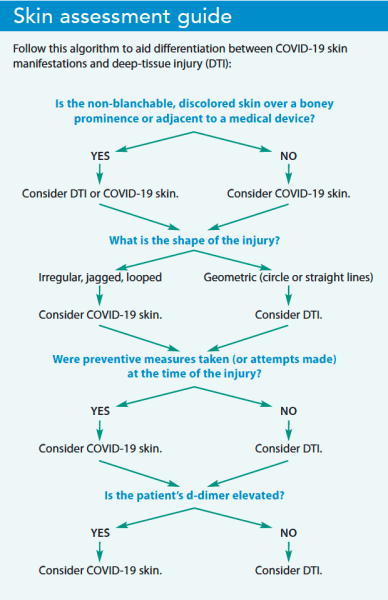 Reference guides help nurses accurately assess for and document COVID-19 skin. For example, a guide could begin by asking whether the patient is COVID-19 positive. If they are and also have non-blanchable maroon or purple lesions, the next decision points should reflect the unique characteristics of the lesion, the treatment plan, and the patient’s clinical status.
Reference guides help nurses accurately assess for and document COVID-19 skin. For example, a guide could begin by asking whether the patient is COVID-19 positive. If they are and also have non-blanchable maroon or purple lesions, the next decision points should reflect the unique characteristics of the lesion, the treatment plan, and the patient’s clinical status.
Diagnosis of COVID-19 skin manifestation may require a change in treatment plan, which might include talking with the patient and family about expected long healing times and possible lack of healing. If the injury site becomes an open wound, the potential for infection might require debridement. However, the patient’s clinical condition generally requires conservative management, including treatment with moisturizing or steroid creams.
For successful classification of COVID-19 skin manifestations, a reference guide should be placed in a centrally located repository and also at the point of care. Using currently established communication strategies to reinforce the use of the guide will help facilitate nursing comfort and sustain the practice. (See Skin assessment guide.)
Be aware
The complex management that COVID-19 brings to the bedside requires that frontline caregivers have access to reference guides that help ease their burden and provide the best care for patients. In addition, clinicians must be aware of all the complications of COVID-19, not just those related to the respiratory system. We help each other by sharing information and providing easily accessible resources to guide our care.
Lisa Goode is a medical–surgical clinical nurse specialist in the Department of Defense in Kentucky. Beth Quatrara is an assistant professor of nursing, DNP program director, and adult-gerontology clinical nurse specialist coordinator at the University of Virginia School of Nursing in Charlottesville. Richard Ridge is an assistant professor of nursing and clinical nurse leader program co-director at the University of Virginia.
American Nurse Journal. 2023; 18(12). Doi: 10.51256/ANJ122320
References
Chand S, Rrapi R, Lo JA, et al. Purpuric ulcers associated with COVID-19: A case series. JAAD Case Rep. 2021;11:13-9. doi:10.1016/j.jdcr.2021.01.019
Black J, Cuddigan J. Skin manifestations with COVID-19: The purple skin and toes that you are seeing may not be deep tissue pressure injury. National Pressure Injury Advisory Panel. 2020. cdn.ymaws.com/npiap.com/resource/resmgr/white_papers/COVID_Skin_Manifestations_An.pdf
Black J, Cuddigan J, Capasso V, et al. Unavoidable pressure injury during COVID-19 crisis: A position paper from the National Pressure Injury Advisory Panel. 2020. cdn.ymaws.com/npiap.com/resource/resmgr/white_papers/Unavoidable_in_COVID_Pandemi.pdf
European Pressure Ulcer Advisory Panel, National Pressure Injury Advisory Panel and Pan Pacific Pressure Injury Alliance. Prevention and Treatment of Pressure Ulcers/Injuries: Clinical Practice Guideline. 2019. internationalguideline.com/2019
Jindal R, Chauhan P. Cutaneous manifestations of coronavirus disease 2019 in 458 confirmed cases: A systematic review. J Family Med Prim Care. 2020;9(9):4563-9. doi:10.4103/jfmpc.jfmpc_872_20
Lee DS, Mirmirani P, McCleskey PE, Mehrpouya M, Gorouhi F. Cutaneous manifestations of COVID-19: A systematic review and analysis of individual patient-level data. Dermatol Online J. 2020;26(12):13030/qt7s34p8rw
Li H, Zhao Y, Zhou L, Hu J. Cutaneous, skin histopathological manifestations and relationship to Covid-19 infection patients. Dermatol Ther. 2020;33(6):e14157. doi:10.1111/dth.14157
Marzano AV, Genovese G, Fabbrocini G, et al. Varicella-like exanthem as a specific COVID-19–associated skin manifestation: Multicenter case series of 22 patients. J Am Acad Dermatol. 2020;83(1):280-5. doi:10.1016/j.jaad.2020.04.044
Pontieri-Lewis V, Emmons KR, Scardillo J, et al. COVID-19 skin manifestations: A guide for WOC nursing practice. J Wound Ostomy Continence Nurs. 2021;48(5):410-4. doi:10.1097/WON.0000000000000809
Perna A, Passiatore M, Massaro A, et al. Skin manifestations in Covid-19 patients, state of the art. A systematic review. Int J Dermatol. 2021;60(5):547-53. doi:10.1111/ijd.15414
Seirafianpour F, Sodagar S, Pour Mohammad A, et al. Cutaneous manifestations and considerations in COVID-19 pandemic: A systematic review. Dermatol Ther. 2020;33(6):e13986. doi:10.1111/dth.13986
Swoboda L. Cutaneous manifestations of COVID-19 in critical care. AACN Adv Crit Care. 2022;33(2):186-95. doi:10.4037/aacnacc2022483
Zhao Q, Fang X, Pang Z, Zhang B, Liu H, Zhang F. COVID-19 and cutaneous manifestations: A systematic review. J Eur Acad Dermatol Venereol. 2020;34(11):2505-10. doi:10.1111/jdv.16778
Key words: COVID-19, skin manifestations, deep-tissue injuries


